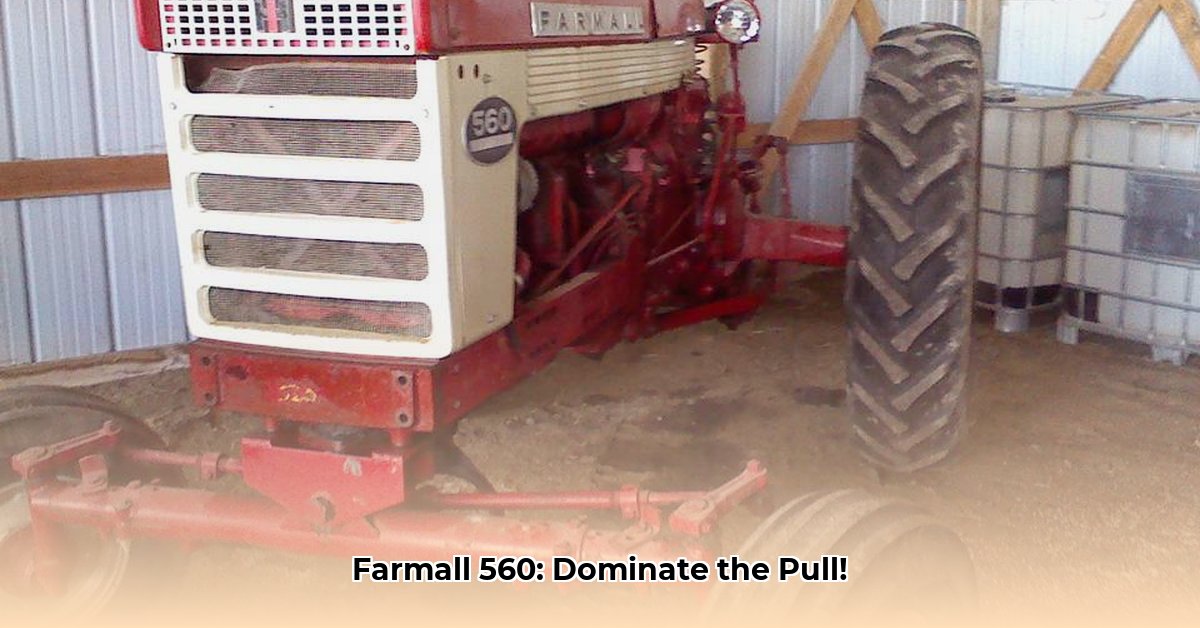
Getting your Farmall 560 or 460 ready to dominate the tractor pull? This comprehensive guide provides expert advice and actionable steps to maximize your tractor's pulling power and ensure you're competition-ready. Let's get you geared up for victory! For even more tips and tricks, check out this helpful Farmall Tractor Pulling Guide.
Understanding Weight Classes and Regulations: The Foundation of Success
Before you even consider engine modifications, you must understand the weight regulations. These aren't suggestions; they're the rules of competition. Weight limits vary significantly between events, ranging from 5,500 pounds to considerably more. Always consult the specific rulebook for your chosen event. Failure to comply results in immediate disqualification. Knowing these rules is the first step to victory.
Optimizing Weight Distribution: Finding Your Tractor's Sweet Spot
Weight isn't just about the total; it's about where that weight resides. Optimal weight distribution prevents wheelies (too much weight forward) or wheel spin (too much weight rearward). Achieving the perfect balance often requires experimentation. Strategic ballast placement is key, and the ideal distribution may vary depending on track conditions. This is where trial and error will become your best teacher.
Tire Selection: The Crucial Link Between Power and the Ground
Your tires are the critical interface between your tractor's power and the pulling surface. Choosing the right tires is crucial. Popular choices include 18.4-34s and 16.9 x 38s, but the optimal size depends on many factors, including the weight class, the track's condition (hard-packed clay vs. soft soil), and even personal preference. Tread pattern matters too; a deeper tread provides superior grip in softer soil. Remember, bigger isn't always better. Select tires that perfectly meet weight and track specifications. Always consult with experienced pullers and tire specialists to get reliable advice. Isn't optimal traction essential for winning?
Engine Tuning and Modifications (Within Regulations): Unleashing Responsible Power
Want more power? Careful engine modifications, within the rules, can make a significant difference. However, proceed with caution. Significant modifications risk engine failure, resulting in costly repairs and potentially voiding your warranty. If unsure, seek professional help from a mechanic experienced with Farmall 560s and tractor pulling regulations. Safety and adherence to rules are paramount. Do you want to risk costly repairs for an edge that might not even be within the rules?
Pre-Competition Preparation Checklist: A Step-by-Step Guide to Success
Before you even start the engine, a meticulous pre-competition checklist is vital. Skipping this step compromises performance and safety. Here's a comprehensive guide to get you race-ready:
- Engine Fluids: Check and top off oil, coolant, and fuel. Low fluids are a recipe for disaster.
- Transmission Check: Ensure smooth shifting. Transmission issues will severely hinder performance.
- Brake Check: Thoroughly inspect brakes before even starting the engine. Proper stopping is non-negotiable.
- Weight Verification: Double and triple-check your total weight, including ballast, to ensure you meet the weight class requirements.
- Tire Pressure: Adjust tire pressure based on track conditions. Improper tire pressure significantly reduces traction.
- Safety Inspection: Perform a thorough inspection of all components, checking for loose or damaged parts.
Troubleshooting Common Problems: Addressing On-the-Spot Issues
Even with diligent preparation, problems can arise. Here's how to address some common issues:
- Overheating: Immediate shutdown and cooling are essential. Check coolant levels, belts, and the radiator for damage.
- Traction Loss: Examine tire pressure, weight distribution, and track conditions.
- Mechanical Failures: Regular preventative maintenance minimizes the risk of unexpected failures.
Risk Assessment and Regulatory Compliance: Staying Within the Rules
Modifying your tractor involves inherent risks. Understanding these risks and adhering to rules is paramount:
| Modification | Risk Level | Mitigation |
|---|---|---|
| Engine Tuning | High | Professional tuning, dyno testing |
| Weight Addition | Low | Secure fasteners, even distribution |
| Tire Change | Low | Proper inflation, pre-event inspection |
Remember, rule compliance is non-negotiable. Disqualification will be a heavy blow.
How to Optimize Farmall 560 Engine for Tractor Pulling Competitions
Key Takeaways:
- Weight reduction is critical for improving performance. Consider lighter wheels, and removal of non-essential parts.
- Engine upgrades significantly boost pulling power but must be within regulations.
- Tire selection is paramount for traction and weight class compliance.
Shedding Weight for Speed: Weight Reduction Strategies
Every pound counts. Lightweight is key. Removing the front-end loader, using lighter wheels, and removing unnecessary parts are simple and effective strategies.
Power Up: Engine Tuning and Modifications (Within Regulations)
Engine modifications can significantly improve your tractor's pulling power. Upgrading to a higher-horsepower engine, like a 301 combine engine with 806 pop-up pistons, is a popular method among competitors, but remember to stay within competition rules..
Tire Tactics: Traction and Compliance
Tire selection requires careful consideration. Balancing traction and weight class restrictions is key. Larger tires often mean moving to a heavier weight class.
Weight Distribution: Finding the Perfect Balance
Correct weight distribution is essential. Experimentation to find the ideal balance for your tractor is necessary.
Pre-Competition Prep: A Checklist for Success
A thorough pre-competition inspection is essential. Check fluids, tires, weight, and safety aspects.
Troubleshooting: Addressing Common Issues
Be prepared to handle common issues such as overheating and traction loss. Regular maintenance is your best defense against mechanical failures.